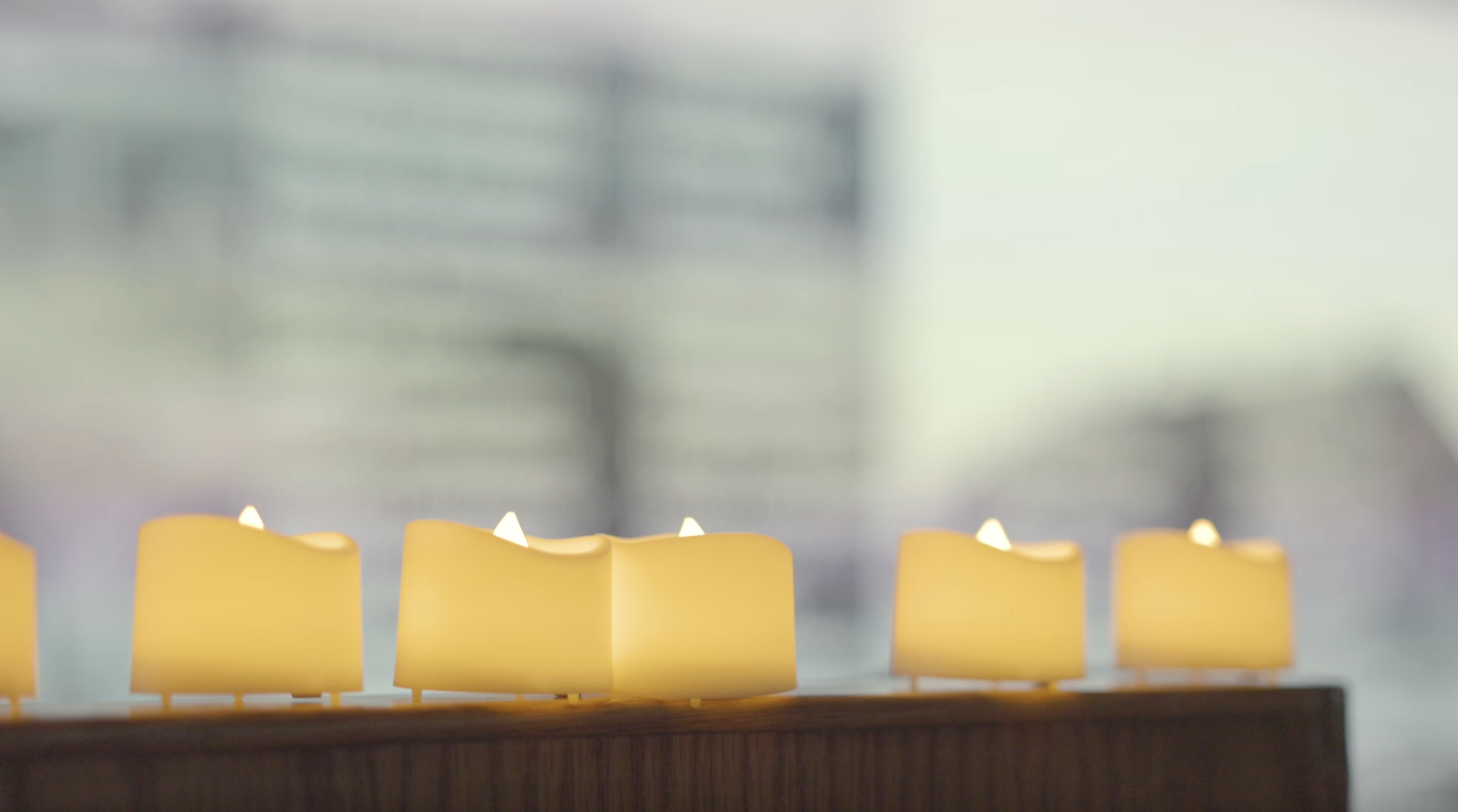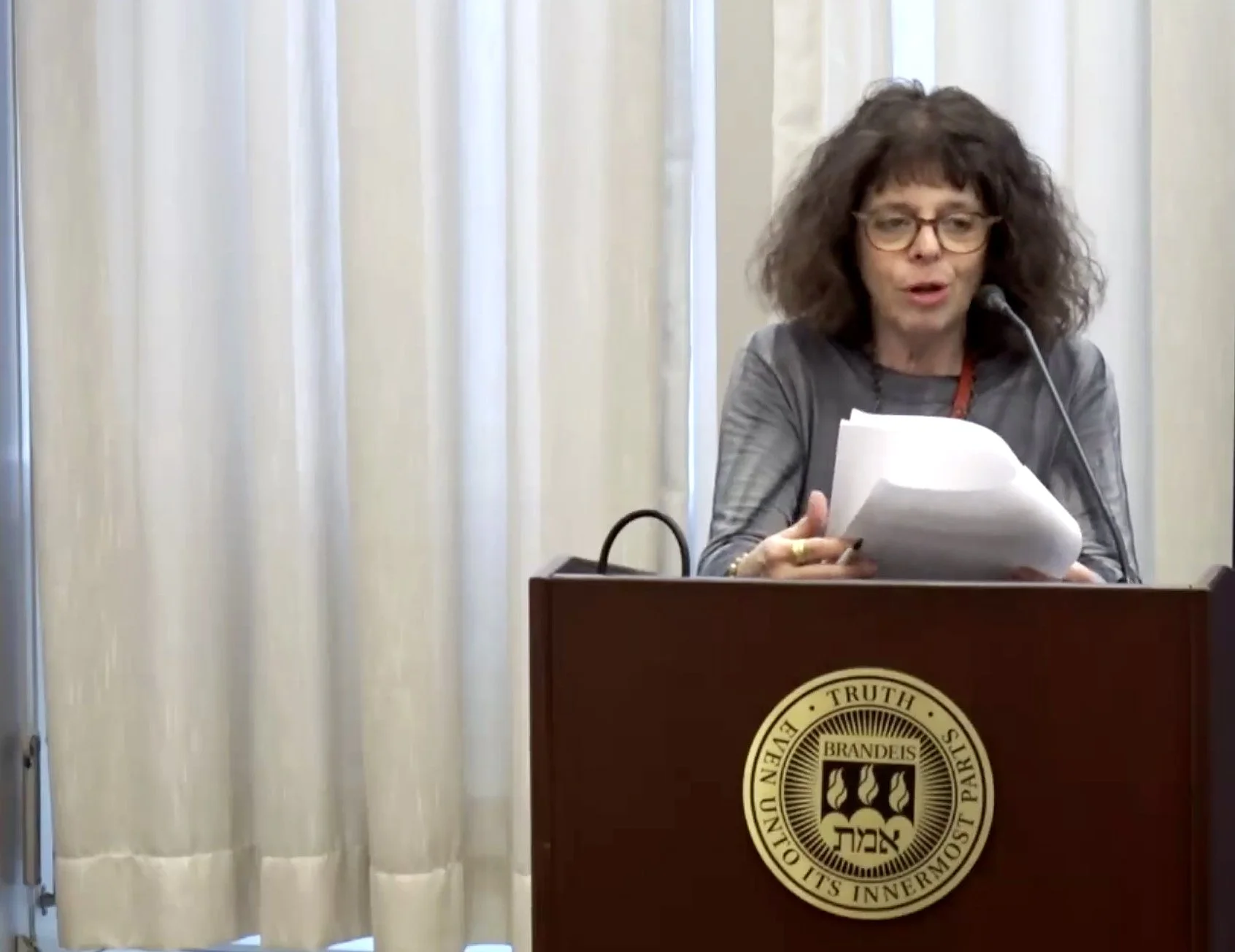Day of Remembrance
Directed and produced by Karen Frostig
April 9 & 10, 2024
The Leonard Bernstein Festival of the Creative Arts
Brandeis University, Waltham, MA
Mourning Shroud (2024). Artists: Karen Frostig, lead artist with Ed Malouf, Jennifer Varekamp and Emily Moughan. Photo credit: Mike E. Dunne
Program features 47 speakers, artists, and performers
Six Videos taken from on site and streaming footage
Community Conversations Video installation about exile, deportations, and belonging. Developed as six unscripted conversations addressing family narratives about memory, loss, and migration, originating in different regions of the world.
Danielle Legros Georges is a poet, literary translator, and editor. The former Poet Laureate of Boston, and Professor Emeritus of Creative Writing at Lesley University,
Karen Frostig, Director and Producer; Mike E. Dunne, Photographer and video editor; Josh Lifton, Video documentation footage
Photographer and video editor: Mike E. Dunne
Documentation video footage: Josh Lifton, Dan Stevens and Dave Ells
Streaming video: Ely Jacobson
Featured Speaker Pete Stern and Panel Presentation
Karen Komar and Dr Peter Schuntermann, Survivors
Pete Stern, Survivor of the Jungfernhof concentration camp and three other camps presents his story followed by panel presentation: “Memory and the Ethics of Memorialization” featuring three speakers: Dr. Thomas Lutz, Emeritus Head, Topography of Terror, Berlin; Prof in Mag. a Hannah M. Lessing, General Secretary National Fund of the Republic of Austria, Vienna; and Ilya Lensky, Director, Museum “Jews in Latvia,” Riga. Moderator, Laurel Leff, Professor of Journalism and Associate Director of Jewish Studies at Northeastern University.
“Public memory is about coming together to remember the past. It is about creating a meeting place where thoughtful dialogue can occur. The Day of Remembrance program follows the evolving protocol of public memory as inclusive, contextual, and truthful. We are here to listen, to learn, to reflect, and to build community.”—Karen Frostig
Dr. Karen Frostig, Founding Director, Locker of Memory project; and Director and Producer, “Day of Remembrance.” project
More than 100 guests were in attendance. Ceremony was co-led by Cantor Alicia Stillman of Temple Israel. Thirty descendants read the names of family members out loud for the first time and Rabbi Benjamin Chaidell of Temple Beth Israel in Waltham recited the Mourner’s Kaddish over these forgotten souls for the first time.
The Ceremony includes music, prayer, poetry, descendants reading namers of loved ones, and an outdoor procession.
Five Survivors of the Jungfernhof Concentration Camp reunite and speak about their memories, 80 years after liberation. Interview by Dr. Karen Frostig.
Introduction by Dr. Alan Stern, son and nephew of two survivors.
Using Science to Uncover the history of the Jungfernhof Concentration camp, Professor Phillip Reeder.
Choral Music Closing, Brandeis Chorus, Robert Duff, Conductor with 23 singers
Additional Content
Professor Phillip Reeder, Geographer and Cartographer. Professor, Center for Environmental Research & Education (CERE), Former Dean (07/13-06/21) Bayer School of Nat. & Envir. Sciences. Now: School of Science and Engineering, Duquesne University.
Program Booklet includes bios for speakers, facilitators and performers, descendants’ statement, and more.
Scientific Research Report 2024
Permission granted by Phillip Reeder and Harry Jol
Publications
CULTURE
Nearly 4,000 Jews died at Jungfernhof, a Nazi camp in Latvia. This artist is fighting for a memorial to them.
BY DEBORAH LYNN BLUMBERG MAY 17, 2024 10:00 AM
Karen Frostig has been working for nearly two decades to build a memorial at Jungfernhof, the Latvian site where the Nazis likely murdered her grandparents. (Courtesy Mike E. Dunne)
Karen Frostig stood on a grassy patch of land near the Daugava River outside Riga in 2007 searching for a sign, a plaque, any marker acknowledging the thousands of Jews whom the Nazis murdered in and around the adjacent woods of towering fir trees over 60 years earlier, including her Austrian grandparents. There was nothing.
https://www.jpost.com/diaspora/antisemitism/article-801601
Tachles the Jewish Magazine, International. KAREN FROSTIG 24.Mai 2024. Richtigstellen
Article syndicated to four additional newspapers:
Article about the laying the foundation for a memorial at Jungfernhof.
IHRA Project
Safeguarding Sites
Latvia
Jungfernhof
History
In 1941, 3,985 Jews from Germany and Austria were deported to Riga, Latvia. Bludgeoned with clubs, prisoners were forced to walk four kilometers in the freezing cold to an abandoned manor on the outskirts of Riga. The estate originally comprised 12 buildings, and five more were constructed by 1947. Occupying roughly 500 acres, the camp operated from 1941– 1944 in unheated animal sheds with broken roofs, no bathroom facilities, and almost no food. Cruelty,barbarism, beatings,random shootings, starvation, and disease were prevalent. Hundreds died in the first few months of captivity. Able-bodied prisoners were transferred to nearby sites to fulfill slave labor assignments. On 26 March 1942, SS officers in collaboration with Latvian auxiliary police sent 1,800 prisoners to the Birkernieki Forest where they were shot into mass graves. The remaining 450 prisoners were forced to turn the camp into a slave labor farm – where they were not allowed to eat the food that they were forced to grow. Camp records, save for deportation lists, were destroyed prior to Germany’s defeat.
History after 1945
Following WWII, Latvia was occupied by the Soviet Union before gaining independence in 1991. Under Soviet occupation, it was forbidden to discuss the Holocaust, the location of mass graves, or the role of Latvians as collaborators. Regarded as an endangered site filled with rubbish and squatters, the former Jungfernhof concentration camp lacked basic signage. A combination of denial, lack of knowledge, vandalism, neglect, and decay contributed to the deterioration of the site. Local residents, predominantly Russian immigrants, were unaware that an abandoned concentration camp with an unmarked mass grave containing up to 800 bodies existed in their midst. In 2017, Latvian officials installed a recreation park and pond at the site. A promenade situated alongside the picturesque Daugava River was designed for people looking for an escape from city life. A colorful mural at the entrance of the park depicts the area’s prior history as home only to the historic Mazjumprava Manor.
Challenges and IHRA Intervention
A sign, located near the mural detailing 800 years of history at the site, contained only one sentence about the Jungfernhof concentration camp. It described the camp as an “agricultural site for forced laborers.” The omission of a description of conditions at the camp was clearly intentional because of its incompatibility with the current use of the site for leisure activities. The leisure park creation in 2017 involved removing camp ruins, uprooting trees, and relandscaping the area, which potentially destroyed traces of the camp before archaeological work could start in 2021 and 2022.This especially related to the geophysical location of the mass grave. Despite numerous requests, nothing has been done to correct the misinformation, distortion, and trivialization of the actual history taking place at the camp. There are now additional plans to build sports facilities and a musical arena at the site. To combat this, an activist and granddaughter of a survivor of Jungfernhof, Professor Karen Frostig, has made artistic and digital interventions through her project Locker of Memory, which has been partially funded through an IHRA grant.
Photo Credit: Karen Frostig, Director of “Locker of Memory” memorial project.
Report submitted by Karen Frostig
The Dead Under the Potato Field
Goldenberg, A. (2024). Frankfurter Allgemeine Zeitung. No. 52, p. 13.
Obstacles and indifference to memorial development at Jungfernhof
Concept
The “Day of Remembrance” is about forgotten histories and belated memory regarding three historic narratives unfolding in Waltham, Massachusetts. The three narratives will include the Jungfernhof concentration camp, Native American history on the land of Brandeis University previously known as Pequusett, and a nearby abandoned cemetery belonging to the Fernald State School for intellectually disabled students.
Introduction
Land holds memory. I grew up in Waltham, as the daughter of a Holocaust survivor. I learned about my family’s Holocaust history while living in a neighborhood populated with first generation immigrants, situated in the immediate vicinity of four large state hospitals for psychiatric care.
The Day of Remembrance program was initially conceived as an isolated memory project about a forgotten concentration camp in Riga, Latvia where my grandparents were killed. As plans for a permanent memorial at the camp paused, I pursued presenting my ideas as an independent artist in conjunction with Brandeis University’s Leonard Bernstein Festival of the Creative Arts.
During the planning phase of creating this important project about memory and issues of responsibility concerning Holocaust history, a media frenzy erupted in Boston newspapers about the Metfern cemetery containing 296 anonymous graves belonging to intellectually disabled students institutionalized at the Fernald State School. A research project dedicated to recovering the names and stories of those buried at the Metfern cemetery was spearheaded by a Brandeis graduate in cooperation with Gann Academy. My mother worked at the Fernald School at the time the cemetery was in use. The historic landmark of the Fernald State School was now being slated for development as a recreation park. Rooted in my childhood years, with so many parallels to my work in Riga, I felt the need to include this story about forgotten memory in Waltham into the Day of Remembrance project.
As a memory artist my work is also attuned to the land. In presenting a mourning shroud about a grave in Latvia to an audience in Waltham, I considered the relationship between the mourning shroud as a cover for the earth and the earth it would cover. I wondered, what is the history of the earth at Brandeis? Might there be traces of human history embedded in the earth? I learned about a new website, sponsored by Native American faculty at Brandeis University, detailing Native American history on campus lands. The mourning shroud took on new meaning. Connected to the land in Waltham as an artifact of healing, the mourning shroud for group burials would now encompass additional stories.
The Mourning Shroud for group burials is a new idea. While the original impetus was directly connected to the Jungfernhof concentration camp, I was also presenting an idea that had many applications in a world that continued to produce new mass graves. One could argue that I should develop a mourning shroud for the world. While there may be a basis for this kind of thinking, in my mind, the concept of a mourning shroud is to restore dignity to an unremembered group of victims. The size of the shroud and the specificity of the shroud needs to be linked to established histories, lacking precedence for commemoration. The separation of the crimes and the timeline of remembrance must also be a consideration.
The Program
The Day of Remembrance program is about memory. It is also about education, how and why we remember. The program centers on three histories of neglect, coupled with belated issues of responsibility. The project leads with Holocaust memory concerning close to 4,000 victims imprisoned at the Jungfernhof concentration camp in Riga Latvia. Native America history on the Brandeis campus and the legacy of an abandoned cemetery belonging to the Metropolitan State Hospital and the Fernald State School will be integrated into a ceremony of remembrance, bringing these three disparate histories together in a shared presentation of commemoration.

























